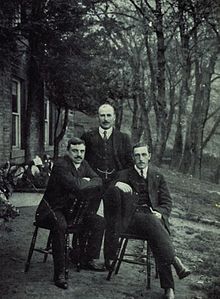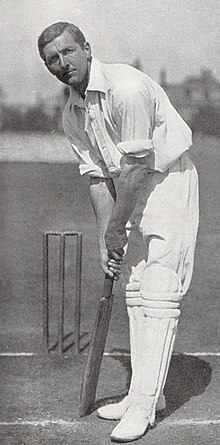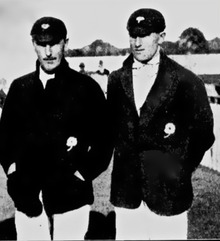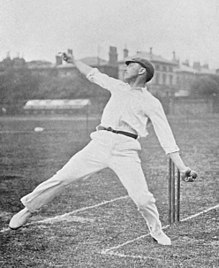Wilfred Rhodes
However, by the First World War he had developed his batting skills to the extent that he was regarded as one of the leading batsmen in England and had established an effective opening partnership with Jack Hobbs.
[5] By now playing regularly for Kirkheaton Second XI, Rhodes's keenness to reach one game on time led him to ring the off-duty bell before the end of the shift and as a result he lost his job.
He decided to change his bowling style to spin, and spent the winter of 1896–97 practising on the family farm while also working again on the railway, this time as a signalman.
[10] At this time Yorkshire were looking for a slow left arm spinner to replace Bobby Peel, who had been sacked following a disciplinary lapse on the field in front of his captain Lord Hawke in August 1897.
[19] In 1899, Rhodes took 179 wickets at an average of 17.10 in a reasonably dry season; this weather meant that pitches were harder, easier to bat on, and less likely to suit his bowling.
[38] Pelham Warner, a leading amateur cricketer and later captain of England, noted that Rhodes was comparatively unsuccessful at the start of the year but came back well to take 193 wickets.
In the event, Warner rated Rhodes the "mainstay of the team",[41] and Wisden observed that he proved critics wrong, establishing himself as the most effective bowler on the tour.
In the first match Rhodes contributed 40 runs to a tenth wicket partnership of 130 with R. E. Foster, who scored 287, to assist the team in building a large lead.
His biographer, Sidney Rogerson, speculates that further deterioration may have been caused by the strain of regular bowling on his fingers and wrist, and his more robust, muscular frame in his mid-twenties.
[43] The relative deterioration in Rhodes's bowling continued into the 1906 season when Wisden commented that he had lost his sharp spin and was not dangerous on a hard wicket.
[57] Rhodes scored 1,721 runs,[18] now regularly opening the batting, and completed another double with 128 wickets, but the Wisden correspondent did not believe this compensated for his lost bowling.
[87] After the Test series ended, several amateur members of the team wanted to extend the tour into Rhodesia, but the professionals refused to take part as their contracts did not cover this and they would have effectively played for no wages.
Rhodes, although not the ring-leader, was influential in this strike, and a sports newspaper, Winning Post, singled him out as responsible in an article highly critical of him and the other professionals.
The bowling attack was weaker: Hirst's age lessened his effectiveness with the ball, Major Booth was killed in the war, and Alonzo Drake died from illness in January 1919.
The tourists, as Wisden reported, overwhelmed England, exposing many weaknesses in the team, and reduced the English selectors to "catch[ing] at straws".
[141] At the time, it was suggested his place was lost because he was uncomfortable against the fast bowling of Jack Gregory and Ted McDonald,[142] who devastated and demoralised many English batsmen during the season.
Critics complained that this method was ugly; it restricted the shots that could be made, and led to some batsmen using their pads as an extra form of defence to stop the ball hitting the wicket.
[17] In the autumn, he travelled to India, coaching and playing for the Maharaja of Patiala's private team; Rhodes repeated this trip every year until 1927, sometimes accompanied by other players.
[148] Although he imparted less spin to the ball than in his younger days, he continually bowled a good length and placed fielders in positions which very effectively blocked the scoring opportunities of the batsmen.
Lupton, hoping to score some easy runs, came out of the amateur dressing room with his bat when a young professional touched his arm and said, "It's all right, sir.
[156] Beverley Lyon, who captained Gloucestershire between 1929 and 1934, criticised Rhodes for insisting young professionals take the game seriously, thus promoting a no-risk attitude.
[159] With Rhodes in such good form and leading the bowling averages, the selectors tried to convince him to play for England on several occasions through the season but he refused on the grounds that younger men should be chosen.
However, Hobbs and Sutcliffe put on 172 runs for the first wicket and England eventually scored 436, leaving Australia to make 415 to win in unfavourable conditions for batting.
Wisden's judged Rhodes's selection to be "crowned with complete success", his bowling "proving no small factor in determining the issue of the struggle.
[169][170][171] By 1927, Yorkshire wished to appoint a more competent and permanent captain, instead of continuing the succession of ineffective amateurs, and planned to ask Herbert Sutcliffe, a professional, to take the post.
However, Rhodes's personality and generally critical nature did not communicate well to privileged schoolboys who were accustomed to getting their own way, and he was eventually replaced with the more genial and sympathetic Middlesex professional Patsy Hendren.
[186] Cricket writer E. W. Swanton described how Rhodes had "a beautifully controlled, economical and rhythmical action which ensured supreme accuracy of length and direction.
[191] A right-handed batsman with a good defensive technique, Rhodes was a strong driver of the ball who scored more quickly in the earlier part of his career.
[191] Neville Cardus, in his obituary of Rhodes, said that the Yorkshireman "made himself into a batsman by practice and hard thinking", and that while often "dour and parsimonious", he was capable of hitting out.
[19] After changing to the two-eyed stance more of his runs came on the leg-side;[191] in later years, Rhodes often used his pads rather than play a shot, a tactic generally regarded as negative.






